Taste Mumbai
As iconic as London is to the UK, Mumbai is to India. This Alpha city is India’s financial powerhouse, one of the world’s top ten centres of commerce and one of the most populous urban regions in the world.
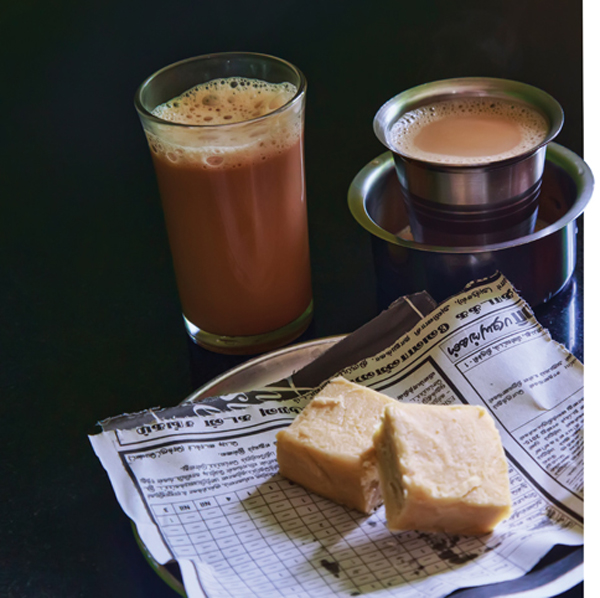
It’s the country’s fashion capital, entertainment HQ, and the trigger point of religious tension. It’s also home to one of Asia’s biggest slums, yet has some of the world’s most expensive real estate. But above all else, Mumbai is India’s food capital: here you’ll sample food that’s only made in Mumbai and nowhere else on earth – not even in India!
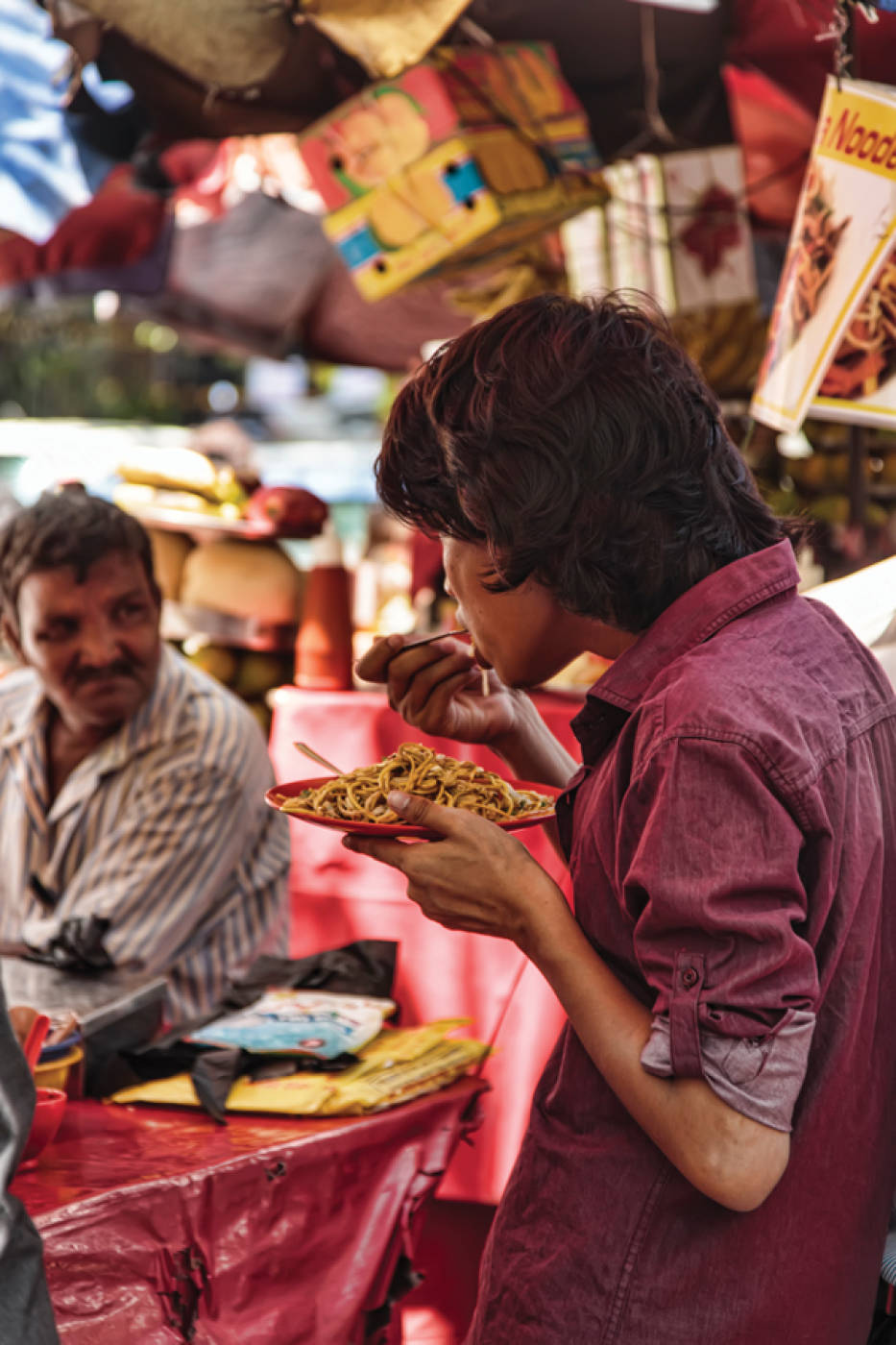
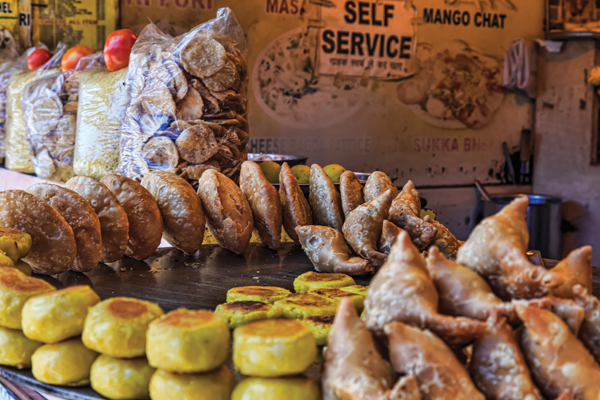
Being a bit of a foodie I’m always partial to experiencing exotic new cuisines– which puts Mumbai’s street food, sold by hawkers from portable stalls, right up there. Wherever you find a cluster of people, you’re guaranteed to find a fleet of street food vendors who find business opportunities everywhere – from crowded railway stations and colleges to high-rise office blocks or the city’s favourite night spots. It cuts across barriers of class, religion, gender and ethnicity. Once I settle into the city’s chaotic and noisy vibe I plunge right in and seek advice from the locals, who were eager to share the location of a few gem stalls tucked away in back alleys.
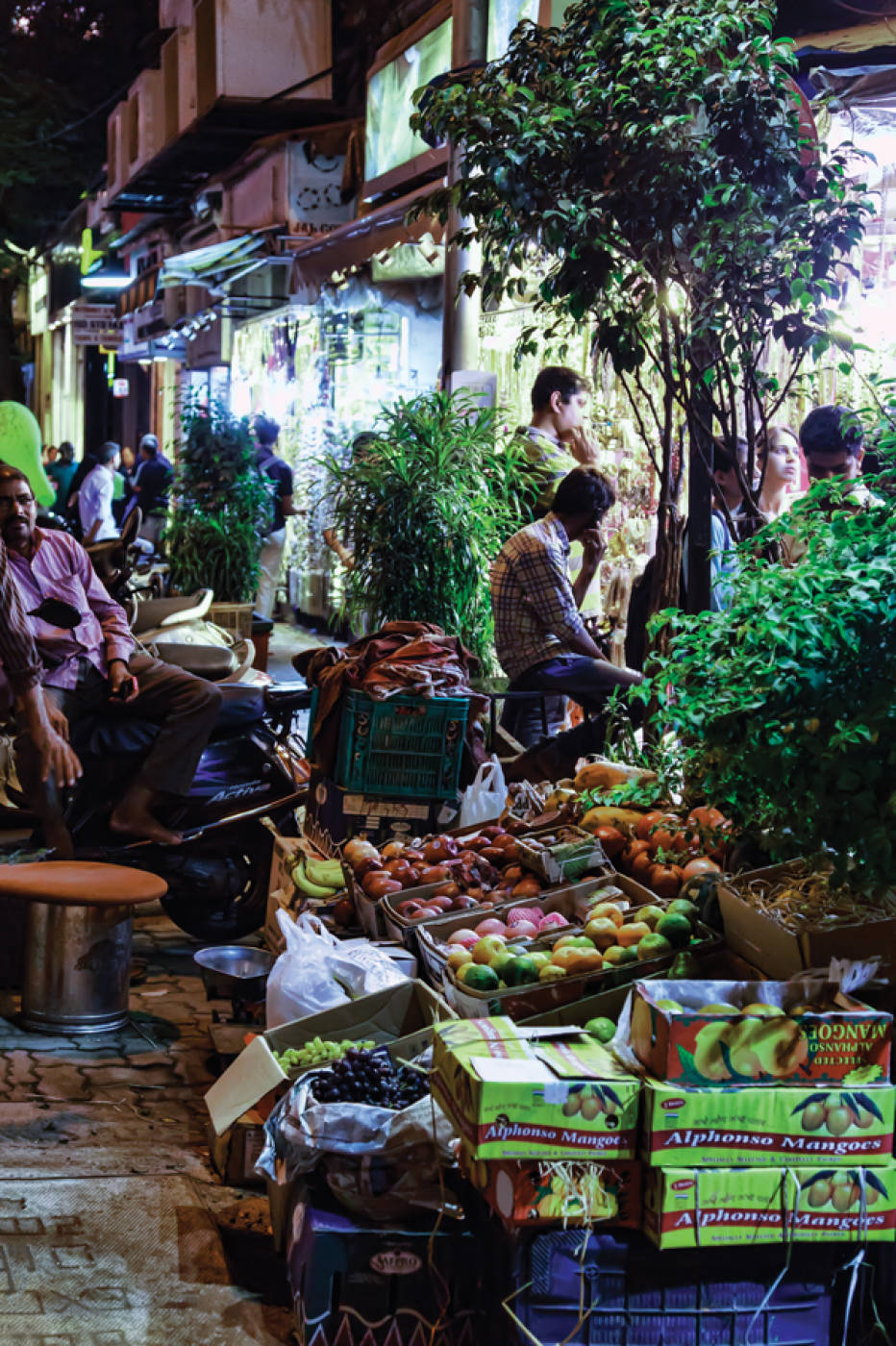
The lightning quick flicks of a knife blade caught my eye as a vendor chops a lush crop of coriander, ready for his panipuri’s. Arranged on a small tray are sprouted lentils, a pyramid of golden chickpeas and fragrant lime quarters. A customer stands across from the vendor, eating his panipuri’s – popping them whole in his mouth. Panipuri is a common street snack that’s popular everywhere. It consists of a round, hollow puri (unleavened deep-fried Indian bread) fried till crisp and filled with a mixture of flavoured water, tamarind chutney, chili, chaat masala (a spice powder mix), potato, onion and chickpeas. There is nothing more divine than the burst of flavour when you close your mouth around the thin shell of Puri, causing it to explode and have the ingredients do their magic on your taste buds.
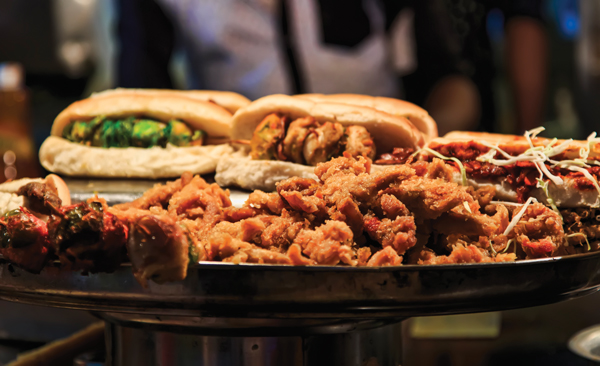
Equally as popular is bhelpuri – a crunchy, moreish and surprisingly complicated savoury snack, delicately balanced between sweet, tangy, spicy and sour. It consists of puffed rice mixed with raw tomatoes and onions which are seasoned in a tamarind sauce. It’s particularly good at Juhu and Chowpatty beach, accompanied by an icy glass of limbu pani, Indian limeade.
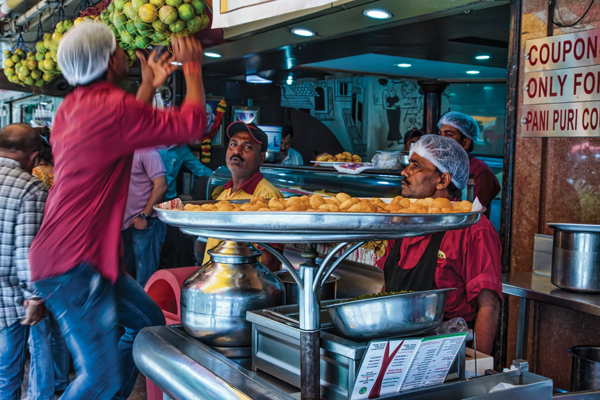
Another great snack is Dahi batata puri – puri shells partially filled with mashed potatoes or chickpeas, followed by a small amount of chilli powder, sweet tamarind chutney and spicy green chutney. Finally, sweetened yoghurt is generously poured over the shell, and the finished product is garnished with a sprinkling of crushed fried noodles, mung beans and finely chopped coriander.
The most popular street food in Mumbai is Vada Pav: a deep-fried potato patty with some coriander and spices. Commonly referred to as a ‘poor man’s burger’ and is available on every street. Vada is a mashed potato fritter which is stuffed into the Pav, which is Indian for a bread bun. This mouth-watering meal is served with spicy and sweet chutneys, fried chilies and garlic chutney. There are tens-of-thousands of Vada Pav stalls in Mumbai, some very distinctive in style, like the Anand Vada Pav stall opposite Mithibai College in Vile Parle.
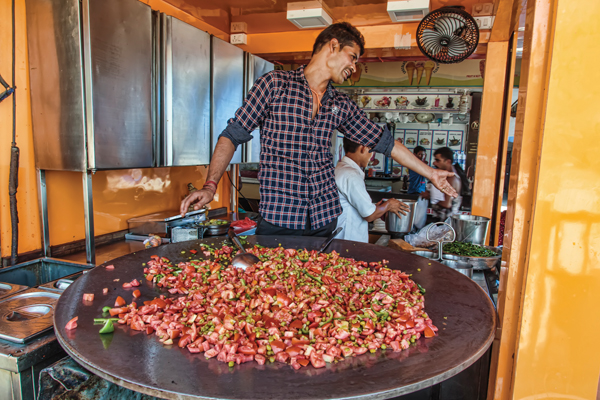
Then there’s Pav bhaji, the ultimate in Indian comfort food and arguably the quintessential Mumbai street food. The Bhaji is mashed potatoes and vegetables cooked with tomatoes in a butter-rich spiced sauce until it becomes a soft purée. This is served with a soft Pav which is lightly toasted in a pan with butter. It is presented on a tray with sides of onions, a piece of lemon, tomatoes, a fistful of coriander, and most importantly – a wedge of butter. This is eaten with the hands (always the right hand) and often extra pav is ordered to soak up the juices. If the bread is yellow, you know you’re in for a treat. To experience the best of the best, visit the Cannon Pav Bhaji (Dr Dadabhai Naoroji Road) which started off as a stall but now has made a proper shop but still has a stall feel to it.
Mumbai has a cultural rhythm all of its own; one you’ll only experience through its food – a complex taste amalgamation of classic, robust flavours and modern, inventive refinements – patties, puris, kebabs and lassis – everyone, from billionaire to bum relishes the street food of Mumbai, the city of a million hawkers, the city of dreams.
Most street food tends to be vegetarian, which is not just a religious dietary requirement for the most, but a practical arrangement too, due to the lack of refrigeration and storage facilities in searing temperatures.
There are a few exceptions of course, one’s who buy and cook meat immediately like Frankie, who’s flour wraps are filled with mutton, eggs, mashed potatoes, chicken, and just about anything else you can imagine. The main ingredients, inspired by Lebanese-style pita wraps – are often complemented by raw onion and spicy sauces. Although there are many Frankie stalls around Mumbai, the best one is on Andheri Kurla Road, Andheri East.
Another prevalent dish in Mumbai is Kheema Pav. It is Pav with a dish of minced meat which, like everything else, is cooked in spices, and served with many sides like lemons, onions, and pickles. Although not really a roadside stall Olympia Coffee House (next to the Police Station in Colaba), has the best Kheema Pav you will find in the city.
Originating in the Middle East, kebabs are one delicacy that has solidified its culinary hold over Mumbai’s non-vegetarians. It essentially consists of chunks of fish or meat that are marinated and grilled on a skewer over a makeshift barbeque pit. A popular street stall-turned-shop in this case is Bademiya (off Horniman Circle, Kala Ghoda) who has a full house every night.
Mumbai-style sandwiches are a staple street-side stomach filler. Slices of bread are liberally pasted with butter and the ever-present green chutney. It is loaded with slices of cucumber, beetroot and onion, then toasted over hot coals. There are limitless variations to the Mumbai sandwich: butter, mayonnaise, cheese, Schezwan, egg, vegetable. Baba’s Sandwich stall near Mithibai College is the ultimate sandwich man and has a constant crowd of students queuing for his sandwiches.
After these spicy sensations, I indulge my taste buds to a few super-sweet treats. Starting with Jalebi – a fried pastry drizzled in syrup. Then there’s Rasgulla — cheese dumpling cooked in syrup, followed by Ras malai, a sweet cream, eaten after a meal. I continue my sweet quest through the crowded streets onto J. Jalebi (opposite Roxy on Tata Road) for amazing desserts. The round orange balls, called motichoor ka laddoo, are delicious. They resemble pretzels and taste like deep fried donuts dipped in cold, sugary water – you’ve never had anything like this before. It’s worth seeking out the stall of Mukesh Sharman, found at the start of Colaba Market on Lala Nigam Road. I sampled several scoops of his Kulfi – a creamy and dense kind of ice-cream dessert made of sweet condensed milk which is then frozen. Ask after Kaju-Anjeer kulfi made with cashew nuts and figs. Simply glorious. I could feast at this stand three times a day!
Apart from snacks, Mumbai has several juice and milkshake bars. Try a Masala milk or watch fresh sugar cane juice (gnaes) being crushed at a stall – delicious! Then there’s falooda, a sweet flavoured milk, with vermicelli, tapioca pearls and chunks of gelatine. Traditionally it’s made with rose-flavoured milk and enhanced with rose syrup. These days, one would even find a scoop of ice cream in the glass – a chilled glass of heaven! Badshah’s (opposite Crawford Market) is ultra-famous for serving the best Faloodas in Mumbai.
Strolling along Mumbai’s chaotic streets is like walking through gradually unfolding pages of history, passing balconies hanging from colonial homes, glimpsing walls inside traditional dwellings draped with neck-stretching urban art in psychedelic colours. Speak with locals about their food, will have them talking about their lives.
Checking in
The Abode Boutique Hotel – don’t judge a book by its cover applies here. From the outside it looks glum but walk up the wooden stairs to the first floor and you’re met with something quite spectacular. Leading through ornate wood and glass doors is a tall, colonial-styled room comprising, on one side of a narrow chimney-breast is a breakfast room (which serves a rather luxurious continental breakfast) with a 12-seater wooden dining table at its centre. Suspended above the table is an immense crystal chandelier. Ask after room 108 – it has a tall Banyan tree right outside its window. It has all the modern-day requirements you’ll need, including a flat-screen TV and free WiFi. Room prices start at Rs4,000 a night and includes breakfast.
www.abodeboutiquehotels.com
To plan your trip to Mumbai visit www.incredibleindia.org